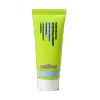What's inside
What's inside
 Key Ingredients
Key Ingredients

 Benefits
Benefits

 Concerns
Concerns

No concerns
 Ingredients Side-by-side
Ingredients Side-by-side

Water
Skin ConditioningPolyacrylate Crosspolymer-6
Emulsion StabilisingGlycereth-7 Triacetate
EmollientPanthenol
Skin ConditioningGlycerin
HumectantSodium Hyaluronate
HumectantHydroxypropyltrimonium Hyaluronate
Hydrolyzed Hyaluronic Acid
HumectantSodium Acetylated Hyaluronate
HumectantHyaluronic Acid
HumectantSodium Hyaluronate Crosspolymer
HumectantHydrolyzed Sodium Hyaluronate
Skin ConditioningPotassium Hyaluronate
Skin ConditioningBiosaccharide Gum-1
HumectantPoria Cocos Polysaccharide
Skin ConditioningChondrus Crispus Extract
Skin Conditioning1,2-Hexanediol
Skin ConditioningCaprylyl Glycol
EmollientButylene Glycol
HumectantSodium Levulinate
Skin ConditioningGlyceryl Caprylate
EmollientSodium Anisate
AntimicrobialXanthan Gum
EmulsifyingGluconolactone
Skin ConditioningSodium Gluconate
Skin ConditioningSodium Benzoate
MaskingPotassium Sorbate
PreservativeCalcium Gluconate
HumectantCitric Acid
BufferingWater, Polyacrylate Crosspolymer-6, Glycereth-7 Triacetate, Panthenol, Glycerin, Sodium Hyaluronate, Hydroxypropyltrimonium Hyaluronate, Hydrolyzed Hyaluronic Acid, Sodium Acetylated Hyaluronate, Hyaluronic Acid, Sodium Hyaluronate Crosspolymer, Hydrolyzed Sodium Hyaluronate, Potassium Hyaluronate, Biosaccharide Gum-1, Poria Cocos Polysaccharide, Chondrus Crispus Extract, 1,2-Hexanediol, Caprylyl Glycol, Butylene Glycol, Sodium Levulinate, Glyceryl Caprylate, Sodium Anisate, Xanthan Gum, Gluconolactone, Sodium Gluconate, Sodium Benzoate, Potassium Sorbate, Calcium Gluconate, Citric Acid
Water
Skin ConditioningNiacinamide
SmoothingPolysilicone-11
Methyl Methacrylate Crosspolymer
Polymethylsilsesquioxane
Glycerin
HumectantC13-15 Alkane
SolventLactobionic Acid
BufferingSilica
AbrasivePolyacrylate Crosspolymer-6
Emulsion StabilisingTriheptanoin
Skin ConditioningAlpha-Glucan Oligosaccharide
CleansingPhenoxyethanol
PreservativeEthylhexylglycerin
Skin ConditioningSodium Gluconate
Skin ConditioningLaureth-12
EmulsifyingPropanediol
SolventHyaluronic Acid
HumectantSodium Hydroxide
BufferingCitric Acid
BufferingNymphaea Caerulea Flower Extract
Skin ConditioningNelumbo Nucifera Flower Cera
Skin ConditioningWater, Niacinamide, Polysilicone-11, Methyl Methacrylate Crosspolymer, Polymethylsilsesquioxane, Glycerin, C13-15 Alkane, Lactobionic Acid, Silica, Polyacrylate Crosspolymer-6, Triheptanoin, Alpha-Glucan Oligosaccharide, Phenoxyethanol, Ethylhexylglycerin, Sodium Gluconate, Laureth-12, Propanediol, Hyaluronic Acid, Sodium Hydroxide, Citric Acid, Nymphaea Caerulea Flower Extract, Nelumbo Nucifera Flower Cera
 Reviews
Reviews

Ingredients Explained
These ingredients are found in both products.
Ingredients higher up in an ingredient list are typically present in a larger amount.
Citric Acid is an alpha hydroxy acid (AHA) naturally found in citrus fruits like oranges, lemons, and limes.
Like other AHAs, citric acid can exfoliate skin by breaking down the bonds that hold dead skin cells together. This helps reveal smoother and brighter skin underneath.
However, this exfoliating effect only happens at high concentrations (20%) which can be hard to find in cosmetic products.
Due to this, citric acid is usually included in small amounts as a pH adjuster. This helps keep products slightly more acidic and compatible with skin's natural pH.
In skincare formulas, citric acid can:
While it can provide some skin benefits, research shows lactic acid and glycolic acid are generally more effective and less irritating exfoliants.
Most citric acid used in skincare today is made by fermenting sugars (usually from molasses). This synthetic version is identical to the natural citrus form but easier to stabilize and use in formulations.
Read more about some other popular AHA's here:
Learn more about Citric AcidGlycerin is already naturally found in your skin. It helps moisturize and protect your skin.
A study from 2016 found glycerin to be more effective as a humectant than AHAs and hyaluronic acid.
As a humectant, it helps the skin stay hydrated by pulling moisture to your skin. The low molecular weight of glycerin allows it to pull moisture into the deeper layers of your skin.
Hydrated skin improves your skin barrier; Your skin barrier helps protect against irritants and bacteria.
Glycerin has also been found to have antimicrobial and antiviral properties. Due to these properties, glycerin is often used in wound and burn treatments.
In cosmetics, glycerin is usually derived from plants such as soybean or palm. However, it can also be sourced from animals, such as tallow or animal fat.
This ingredient is organic, colorless, odorless, and non-toxic.
Glycerin is the name for this ingredient in American English. British English uses Glycerol/Glycerine.
Learn more about GlycerinHyaluronic acid is naturally found in healthy skin. It is a humectant, meaning it draws moisture to your skin.
This ingredient helps hydrate, soothe, and protect the skin.
What makes hyaluronic acid so hydrating? It has the capacity to bind or hold large amounts of water.
Fun fact: It is already naturally found in our bodies, such as the fluids of our eyes and our joints.
Studies find this ingredient to have anti-inflammatory and anti-microbial properties. This can help speed up wound-healing.
Hyaluronic acid can be irritating if the molecule has a low-molecular weight, or if the molecules are small.
One study found low-molecular weight hyaluronic acid to be pro-inflammatory, meaning some people may experience irritation. This is because our bodies use hyaluronic acid in the wound-healing process to signal to our bodies, via irritation, that something needs healing.
The same study found high-molecular weight hyaluronic acid to be anti-inflammatory.
These are some other common types of Hyaluronic Acid:
Learn more about Hyaluronic AcidPolyacrylate Crosspolymer-6 is a texture enhancer and pH adjuster.
It is be used to thicken water-based products and create a gel-texture with a velvet feel.
One manufacturer claims this ingredient to have a pH range of 2-8 and to be biodegradable.
Learn more about Polyacrylate Crosspolymer-6This is the synthetic salt of gluconic acid, a form of PHA and mild exfoliant.
It is mainly used to stabilize oil and butter formulations from going bad. Sodium gluconate is a humectant, pH regulator, and chelating agent.
Chelating agents help neutralize unwanted metals from affecting the formulation.
Sodium gluconate is water-soluble.
Learn more about Sodium GluconateWater. It's the most common cosmetic ingredient of all. You'll usually see it at the top of ingredient lists, meaning that it makes up the largest part of the product.
So why is it so popular? Water most often acts as a solvent - this means that it helps dissolve other ingredients into the formulation.
You'll also recognize water as that liquid we all need to stay alive. If you see this, drink a glass of water. Stay hydrated!
Learn more about Water